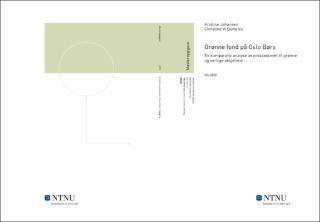| dc.contributor.advisor | Paraschiv, Florentina | |
| dc.contributor.author | Johansen, Kristine | |
| dc.contributor.author | Vu, Christine Vi Dung | |
| dc.date.accessioned | 2021-09-14T17:16:44Z | |
| dc.date.available | 2021-09-14T17:16:44Z | |
| dc.date.issued | 2020 | |
| dc.identifier | no.ntnu:inspera:55684816:59785970 | |
| dc.identifier.uri | https://hdl.handle.net/11250/2777197 | |
| dc.description.abstract | Denne studien er en komparativ analyse av grønne fond mot vanlige fond registrert på Oslo Børs. Formålet med oppgaven er å undersøke om vi kan finne forskjeller i prestasjon for de to fondstypene. Grønne investeringer har hatt en enorm vekst de siste årene, og motivasjonen for denne studien er derfor å kunne utvide kunnskapen om prestasjonen til grønne fond registrert på Oslo Børs, i tillegg til å senke informasjonsasymmetrien som tidligere har vært knyttet til dette temaet.
For å belyse dette ble det konstruert en portefølje med like vekter av 11 grønne fond. Disse ble så matchet med 18 vanlige fond ut fra kriteriene; alder, investeringsstil og størrelse. Analysen benytter daglig fondsdata over en periode på 27 år, fra februar 1992 til juni 2019. For å kartlegge prestasjonen ble kapitalverdimodellen, og to flerfaktormodeller benyttet. Flerfaktormodellene inkluderte faktorene endring i oljepris og endring i kvotepris på CO2-utslipp. Prestasjonsmålene som er benyttet i oppgaven er Jensens alfa, Sharpe ratio og skjevhet- og kurtosejustert Sharpe ratio. Porteføljenes avkastning er også sammenlignet med en markedsindeks; MSCI World Index.
Tidligere forskning antyder at grønne fond har dårligere risikojustert avkastning enn vanlige fond. Denne analysen samsvarer i stor grad med tidligere forskning, og ut fra analysene som er gjort konkluderes det med at grønne fond har hatt dårligere risikojustert avkastning enn vanlige fond gjennom hele analyseperioden. Imidlertid kan man se en positiv utvikling for de grønne fondene, som har forbedret sin prestasjon betraktelig i forhold til de vanlige fondene mot slutten av analyseperioden. | |
| dc.description.abstract | This study explores the performance of green mutual funds registered on Oslo Stock Exchange. The performance measurement framework is implemented by comparing the performance of green mutual fund with their conventional counterpart funds. The purpose of this study is to investigate if we can find any difference in risk adjusted performance for the two fund types. Green investing has had an enormous growth the past years, and the motivation for this study is to expand the knowledge about green funds, in addition to lowering the information asymmetry that previously have been prominent in this subject.
To shed light on this there was constructed an equally weighted portfolio of 11 green funds. These funds were then matched with 18 conventional funds based on the matching criteria: age, investment style and size. This analysis employs daily funds data over a period of 27 years, from February 1992 to June 2019. To analyze the performance of the funds, CAPM and then two multifactor models were used. The multifactor models included the factors change in oil price and change in quota price for CO2-emissions. The performance measurements used in this analysis includes Jensens Alpha, Sharpe ratio and skewness- and kurtosis adjusted Sharpe ratio. The portfolios return is also compared to a market benchmark; MSCI World Index.
Previous research implies that green funds have poorer risk adjusted return than conventional funds. This study matches to a large extent with the previous research, and according to the analysis carried out, it concludes that green funds have had inferior risk adjusted return than the regular funds in this study throughout the entire analysis-period. However, you can see a positive development for the green funds as they have improved their performance considerably in comparison to the conventional funds towards the end of the analysis-period. | |
| dc.language | | |
| dc.publisher | NTNU | |
| dc.title | Grønne fond på Oslo Børs | |
| dc.type | Master thesis | |
